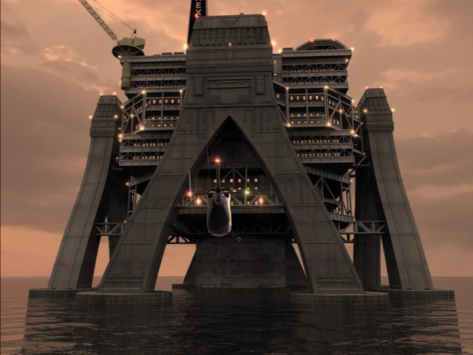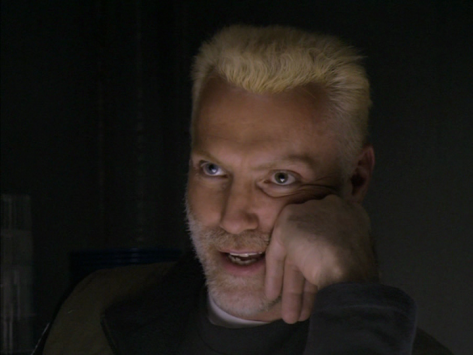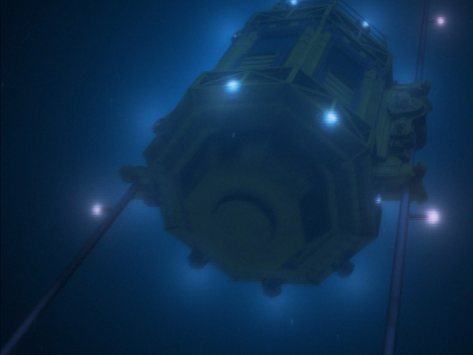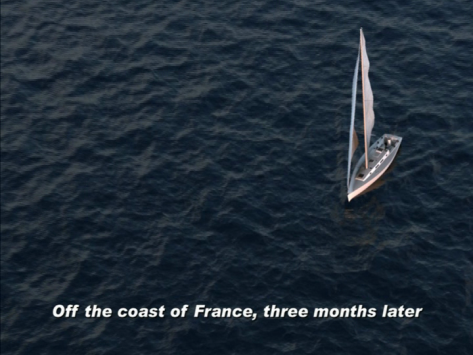
Fusion International Sales Corporation. Directors: Gary J. Tunnicliffe and Pat Corbitt.
Creature Feature Bleachers Award: Most Crew Positions Fulfilled by the Fewest Number of People.
“Megalodon” is pretty good, and when it comes to sharksploitation films, sometimes that’s the best thing you can say. With its middleweight cast but relatively low budget, the film straddles the line between b-movie and mainstream cinema. Clocking in at a stereotypical 91 minutes, “Megalodon” actually leaves you wanting more. It’s not often I say this, but the film could easily have been a half hour longer and I wouldn’t have minded. Note: for those who have accidentally stumbled upon this review, “Megalodon” should not be confused with 2002’s other smash sharksploitation hit, “Shark Attack 3: Megalodon” (review forthcoming).
Peter Brazier (villainous-sounding Robin Sachs) invites reporter Christen Giddings (Leighanne Littrell) to do a feature on his new massive off-shore oil rig. Despite environmental concerns, Peter maintains that the rig is completely safe and will improve lives by providing cheap energy. Though he harbors misgivings about the potential environmental impact, crew member Ross Elliot (Al Sapienza) pilots an exploratory submarine, while Christen, Peter, and the others observe from the rig’s underwater elevator. When the drill breaks through the ocean floor, it uncovers a hidden world of prehistoric sea life. A great boon for science, yes, but a also potential threat for the crew— could there be a megalodon lurking in the shadows?

The DVD Cover
I’m pretty impressed with what the makers of “Megalodon” managed to pull off given the limited tools at their disposal. On the sharksploitation family tree, I would say that the film’s closest cousin is probably Hollywood blockbuster “Deep Blue Sea,” and it shares similarities with “Alien” as well. Who doesn’t like a movie about a scientifically-advanced outpost in a harsh environment, suddenly attacked by a ruthless killer? If that’s not enough for you, the film also draws upon “The Lost World” for inspiration. Unlike the isolated megalodons depicted in such films as “Super Shark” and “Dinoshark,” the titular character of “Megalodon” comes from an underwater pocket teeming with ancient sea life. Not every sharksploitation film starts with the small fry and works its way up to the terror of the prehistoric ocean.
So why, then, do I say that “Megalodon” had a much smaller budget than its Hollywood relatives? It’s not immediately evident from the quality of the movie itself, though the alternating windy/echoey nature of the soundtrack does detract from the overall effect. No, the answer lies in the credits.
A keen eye will note that most crew members wore multiple hats during the production of this film. Consider that the members of two families— Pat and Cathleen Corbitt, and Christine, Linda, and Craig Bocchiarro— fulfilled the roles of director, producer, visual effects producer, additional camera operator, editorial supervision, editorial team, first assistant director, unit production manager, “behind the scenes” camera, art director, title design, still photographer, and travel arrangements. Some of the crew even appear onscreen; writer, director, and creature-designer Gary J. Tunnicliffe also played the role of Grady Harper. Not that it was a small operation or anything…
Another tell-tale sign of thrift is the fact that this 91-minute movie contains a total of 14 minutes of credits. Yep, the old “Jurassic Shark” trick of playing the credits at the beginning, the end, and once again at the end of the film rears its ugly head. I’m also unsure how Matthew Moore could have been both the “First Assistant Camera” and an “Additional Camera Operator.” He was additional to himself?
Any discussion of “Megalodon” that failed to mention Ross’s bizarre appearance would be remiss indeed. Do you remember the unrealistic, block-faced commando action figure from “Small Soldiers”? Add an eerily whitish-yellow beard, and you have Ross.
Seriously, Ross looks like a caricature of a cartoon action hero! Someone call Dr. Quest, we found where Race Bannon’s been hiding! In the course of the film, it’s revealed Ross’s hair was turned white because he spent too much time diving near polluted reefs. This also sounds like a detail from a cartoon character’s backstory. I picture an eco-villain laughing and dumping buckets of bleach in the ocean right after Ross dives in.
I’m equally at a loss to explain the underwater elevator in this film. I don’t see what purpose it serves, other than to be a literal plot vehicle. Though the elevator links the rig with the ocean floor, it appears to have strictly observational capabilities. The mini-subs do all the work, so I don’t see the point of installing an elevator, except so that people can get trapped in it at a dramatic moment.
Finally, every film should have a non sequitur transition like this one:
The trailer is a bit dull:
“Megalodon” is available on Amazon.





